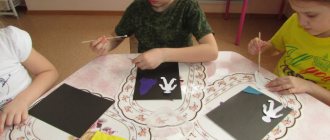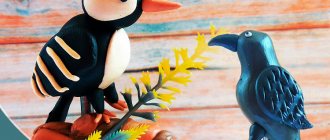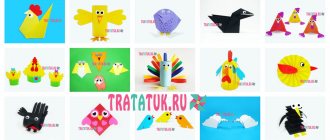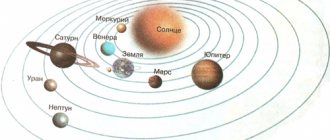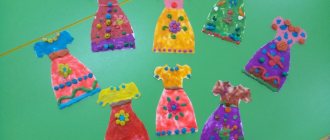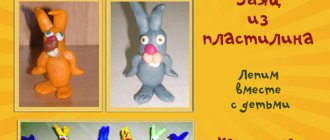Modeling on the theme “Space” with preschool children : a step-by-step master class on making a plasticine picture on the theme of space.
On April 12 we will celebrate Cosmonautics Day. Today, for this day, we will make an amazingly beautiful plasticine picture with the children on the theme “Space”.
Children of senior preschool and primary school age can make this plasticine picture about space themselves. And younger children can help them.
Summary of a lesson in the preparatory group of a kindergarten for Cosmonautics Day
Abstract of the GCD on modeling for the preparatory group “I want to be an astronaut”
Goals and objectives:
To acquaint children with the biography of the first cosmonaut Yu. A. Gagarin;
expand your understanding of modern professions, the planets of the solar system, space travel, and human work in space; consolidate children's knowledge about the properties of lenses; enrich children's vocabulary (vocabulary: meteorite, spacesuit, telescope, space satellite); to cultivate a respectful attitude towards the work of Russian cosmonauts and a desire to be like them. Preliminary work:
looking at illustrations, reading the book “The First Cosmonaut”, parents’ stories about space, observations in the planetarium. Material: illustrations, portraits, books, D / and “What do we know about space?”, plasticine, boards, stacks.
Progress
.
Organizational point
: “What are stars?”
- if they ask you. Answer boldly: “Hot gas!” And add that every star always has a nuclear reactor! Educator: Today we will talk about space, its founders and great people who were pioneers; 2011 became the anniversary year of astronautics. It was on April 12, 1961 that Yu. A. Gagarin made his flight. And now we consider this day to be Cosmonautics Day. The earth is our home in the universe. Let's look at the globe and the map. Our planet is round and only there is life on it. Who tried to invent the rocket? Many years BC, the philosopher Archytas moved a wooden figurine of a dove under the reactive action of steam. Then the Chinese tried to invent a device (like a firework). This topic was thoroughly developed by K. E. Tsialkovsky at the beginning of the 20th century and S. Korolev - during the war years he created Katyusha-type weapons and designed the first rocket launcher. Looking at illustrations, asking riddles:
Miracle bird, scarlet tail.
I would fly around a flock of stars! (Rocket) What can't you do in space? (fall, etc.) In space, through the thickness of years, an icy object flies. His tail is a strip of light. What is the name of the object? (Rocket) White flowers bloom like a fan, and fade in the morning. (Stars) Teacher's conversation about space pioneers. A story about Yu. A. Gagarin. An ordinary sports-trained person. Hardworking, smart, kind. After the war, they became a foundry worker. But since he loved the sky, he dreamed of flying, and after graduating from aviation school he became a pilot. Sitting in the chair of Gagarin's spaceship, he said: “Let's go.” He saw the Earth from space for the first time. Following him, another cosmonaut, German Titov, flew into space. Among the cosmonauts there was also a woman - Valentina Tereshkova. Questions for children:
1. Who invented the rocket?
2. Who was the first space explorer? 3. Who else has flown into space? 4. What should an astronaut be like? 5. What shape is the earth? Physical exercise “Sports warm-up” The teacher unfolds the easel and invites the children to read what is written on it. Children read: astronaut, rocket. Educator: Now we will conduct a sound analysis of words, determine the stressed sound, the number of syllables and compose a sentence with these words. Doing work by children. Finger gymnastics “Cosmonaut” Word games “One - many” Station - many stations. Moon - many moons Cosmonaut - many astronauts. “Name it in order” What? – river No what? - rockets I see what? – the river We came to what? – rocket Are you happy with what? – rocket We’re thinking about what? - about the rocket In the dark sky they sanctify the stars (clench and unclench their fists) An astronaut flies in a rocket (rub palm against palm) Day flies and night flies (clench and unclench fists) And looks down at the ground (image binoculars) He sees fields from above ( spread your arms to the side, palms down) Mountains, rivers and seas (raise your arms up, depicting the height of the mountains) D/I “Fold a rocket” - (Children lay out a rocket from cubes, cut pictures, geometric shapes) Puzzle “What sound is lost?” Educator: And now I suggest you fashion a rocket, if anyone can, a Martian or an astronaut. Clarify the modeling techniques, examine the rocket model, clarify its details. Doing work by children. Analysis and result of the work.
We recommend watching:
A game for children in the preparatory group for Cosmonautics Day. Scenario Entertainment for children of the preparatory group. Solar system Sports festival for Cosmonautics Day for the preparatory group of kindergarten. Scenario Notes on cognitive development on the topic: Space in the preparatory group
Similar articles:
Leisure time in mathematics in the preparatory group for Cosmonautics Day
Cosmonautics Day in kindergarten. Scenarios
MAGAZINE Preschooler.RF
Summary of a lesson in artistic modeling on the topic: “Space travel”Additional education teacher Dyakova M.A. MAU DO "House of Children's Creativity" Pechora 2021 - 2017
Goal: Formation of the foundations of patriotic education.
Tasks:
Educational:
- Gaining insight into the structure of the spacesuit
- Gaining experience in costume modeling
Educational:
- Development of cognitive interest in Cosmonautics Day and space exploration.
- Ability to plan your activities
- Development of creative self-expression, independence and imagination.
Educational:
1. Formation of patriotism, a sense of pride for the Motherland.
Type of lesson:
Thematic, complex (cognitive and developmental activities; artistic and aesthetic).
Lesson form:
Group, individual.
Forms and methods of work:
- Visual: presentation.
- Practical: modeling method.
- Verbal: conversation.
- Partial search: independent work.
Teaching methods:
- visual (auditory and visual) - viewing the presentation
- verbal - conversation
- informative
- problematic - exploratory - understanding the artistic image and searching for techniques and methods of execution
Progress of the lesson:
1. Organizational:
— Do you know what holiday we celebrate on April 12? (children's answers).
— That's right, Cosmonautics Day or International Day of Human Space Flight.
On this day in 1961, the planet's first cosmonaut launched on board the Vostok 1 spacecraft. Who is he? (Children's answers) Yuri Alekseevich Gagarin.
2. Main stage:
— And now I suggest you watch the presentation about this flight.
View the presentation (slides 1-9).
— Guys, what qualities do you think Yuri Gagarin had? (courage, determination, endurance, etc.)
Guys, have you guessed what the topic of our lesson is? (answer options: space, astronauts, space flight, etc.) The topic of our lesson is “Space travel” . Do you want to go on a space journey? I will be the captain of our ship, and you will be the astronauts. And we'll go on a rocket! (ready rocket). We have a rocket, are we in the mood to win? Eat! But something is still missing. What? (leading questions; children’s answers: special clothes, astronaut suit). That's right, spacesuits!
Let's see what a spacesuit is and what it is needed for.
View the presentation. (10-18 slides)
3. Verification stage:
- So why do astronauts need a spacesuit? (For protection from an aggressive external environment; creating an environment similar to that of Earth; heating; providing oxygen; protection from meteorites).
— What color was the space suit of the first cosmonaut, Yuri Gagarin? (Orange)
- Guys, do you remember what parts the spacesuit consists of? Name them. (Helmet, gloves, soft parts, pipeline, safety rope, control panel and others).
-Well done boys! You watched and listened carefully and learned a lot about spacesuits!
Now you know what they are and why astronauts need them.
I initiate you into level 1 astronauts and solemnly present you with an image of a spacesuit, but in order to go on a space journey, we need to finalize our suit. Our spacesuits may vary in color and suit details. But remember the qualities of astronauts, they will help us in our work: independence, resourcefulness, the ability to finish a job, accuracy and precision.
Do you think you have these qualities? Then get to work! In 15 minutes our spaceship sets off on its journey!
4. Practical part of the lesson: (explanation of the task).
— To build yourself a spacesuit, take the blanks, evenly distribute the plasticine over them, add any parts necessary for the astronaut, which can be made from flagella strips, balls, you can use rolling and chopping techniques. Then glue your photo to the helmet and stick a plasticine roller around it. Glue the porthole on top of the roller.
After 15 minutes:
-Guys, who is ready to have their spacesuit checked by the ship's captain?
I see everyone is ready to conquer the vastness of space!!!!
Take your seats and fasten your seat belts!
5,4, 3, 2, 1, Start!
(video of the ship launch, views of the Earth from space accompanied by “cosmic” music, slide 20)
And here we are in space! It's time to leave your mark! Take your image and attach it to a planet or rocket. And this planet is the planet of your mood! If you are in a good mood, take a yellow flag and attach it to the Mood planet, if you are in a normal mood, take a red flag, and if you are in a bad mood, take a blue flag.
Reflection:
Now sit down in your seats and please rate whether it was difficult or not for you in the lesson. Select and paint 1 section of the circle.
flags made of toothpicks and self-adhesive boom, a cup with markers, plates with faces (sad and happy) in which to put flags, a background - space, a rocket, portholes - from bottles, blanks, print out photos of children and cut them out, glue stick, presentations, projector, color. Pencils, music)
| Next > |

